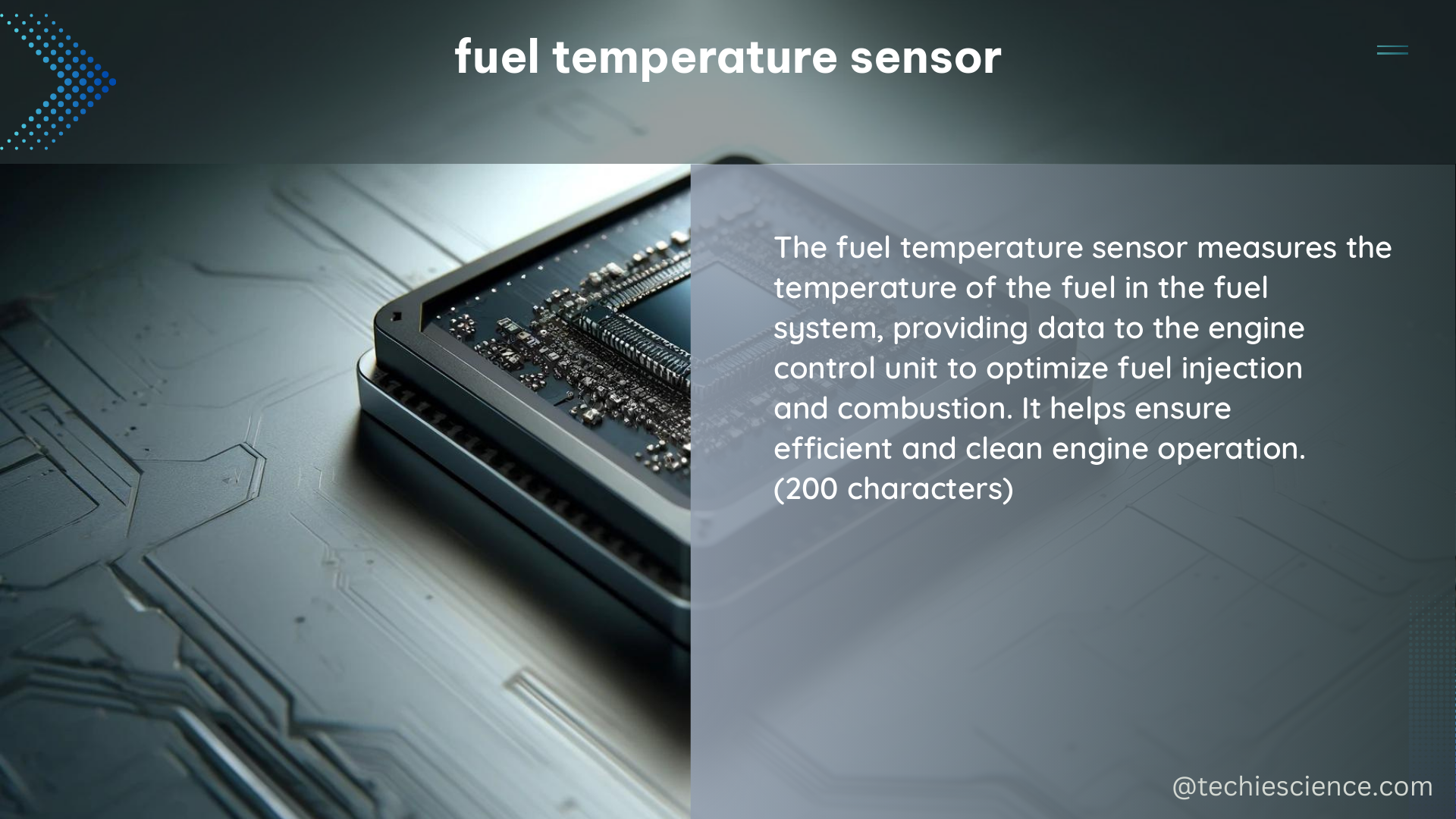The fuel temperature sensor is a crucial component in modern automotive engines, particularly those with direct fuel injection systems. It measures the temperature of the fuel before it enters the engine, which is essential for ensuring optimal fuel atomization, combustion, and emissions.
Understanding the Fuel Temperature Sensor
The fuel temperature sensor is typically a two-wire sensor that measures the resistance of the fuel, which varies with temperature. The resistance can be converted to a temperature reading using a lookup table or a mathematical formula. The sensor’s resistance at different temperatures can be measured and plotted to determine its linearity or non-linearity.
Sensor Resistance and Temperature Relationship
The relationship between the fuel temperature sensor’s resistance and temperature can be expressed as follows:
| Temperature (°C) | Resistance (Ω) |
|---|---|
| 45 | 290 |
| 50 | 260 |
| 55 | 230 |
| 60 | 205 |
| 65 | 180 |
| 70 | 160 |
| 75 | 110 |
From the table, we can see that the sensor’s resistance decreases as the temperature increases, indicating a negative temperature coefficient. This relationship can be used to calibrate the sensor and convert the resistance to a temperature reading.
Sensor Output Voltage
The fuel temperature sensor’s output can be measured in volts or ohms, depending on the engine control unit (ECU) and the sensor’s configuration. For instance, a sensor might output the following voltages at different temperatures:
| Temperature (°C) | Voltage (V) |
|---|---|
| 41.6 | 1.335 |
| 50.2 | 1.012 |
| 60.1 | 0.742 |
| 76.3 | 0.482 |
The ECU uses this voltage signal to determine the fuel temperature and adjust the fuel injection parameters accordingly.
Importance of Fuel Temperature Sensor Accuracy

The fuel temperature sensor’s accuracy is crucial for ensuring proper fuel injection quantity and timing, as well as for diagnosing engine problems. If the sensor is faulty or out of calibration, it can cause issues such as hard starting, rough running, or excessive fuel consumption.
Fuel Injection Optimization
The ECU uses the fuel temperature sensor’s input to adjust the fuel injection parameters, such as the injection timing and quantity. This ensures that the fuel is atomized and combusted efficiently, leading to improved engine performance and reduced emissions.
Diagnostic Applications
The fuel temperature sensor’s data can also be used by the ECU to diagnose engine issues. For example, if the sensor detects a sudden drop in fuel temperature, it could indicate a problem with the fuel delivery system, such as a clogged fuel filter or a malfunctioning fuel pump.
Testing and Calibration
To test the fuel temperature sensor, one can measure its resistance at different temperatures using a multimeter or an oscilloscope. One can also compare the sensor’s output to the ECU’s expected values or to a reference sensor.
Resistance Measurement
To measure the fuel temperature sensor’s resistance, follow these steps:
- Disconnect the sensor from the wiring harness.
- Use a multimeter to measure the resistance between the two terminals of the sensor.
- Compare the measured resistance to the expected values based on the temperature-resistance relationship.
- If the resistance is outside the expected range, the sensor may need to be replaced or recalibrated.
Voltage Measurement
To measure the fuel temperature sensor’s output voltage, follow these steps:
- Connect the multimeter in parallel with the sensor’s output signal wire and ground.
- Start the engine and allow it to reach operating temperature.
- Compare the measured voltage to the expected values based on the temperature-voltage relationship.
- If the voltage is outside the expected range, the sensor may need to be replaced or the ECU may need to be recalibrated.
Sensor Replacement and Calibration
If the fuel temperature sensor is found to be faulty, it can be replaced with a new one. However, it’s important to ensure that the new sensor is properly calibrated to the ECU. This may involve using a diagnostic tool to reset the ECU’s fuel temperature sensor learning, or manually adjusting the sensor’s output to match the ECU’s expected values.
Conclusion
The fuel temperature sensor is a critical component in modern automotive engines, and its accurate measurement and calibration are essential for optimal engine performance and emissions. By understanding the sensor’s resistance-temperature relationship, output voltage, and testing procedures, you can effectively diagnose and troubleshoot any issues related to the fuel temperature sensor.
References:
– Fuel pressure and Fuel temperature sensors – Sideways Technologies. (2020, November 17). Retrieved from https://sideways-technologies.co.uk/forums/index.php
– Mapping an Oil temperature sensor – Page 1 – Engines & Drivetrain. (2013, March 21). Retrieved from https://www.pistonheads.com/gassing/topic.asp?f=66&h=0&t=1264639
– Excessive smoking may be caused by faulty fuel temp sensor | Page 2. (n.d.). Retrieved from https://forums.tdiclub.com/index.php
– Fuel temperature sensor fix – AudiWorld Forums. (2023, February 15). Retrieved from https://www.audiworld.com/forums/a4-b8-platform-discussion-128/fuel-temperature-sensor-fix-3052081/

The lambdageeks.com Core SME Team is a group of experienced subject matter experts from diverse scientific and technical fields including Physics, Chemistry, Technology,Electronics & Electrical Engineering, Automotive, Mechanical Engineering. Our team collaborates to create high-quality, well-researched articles on a wide range of science and technology topics for the lambdageeks.com website.
All Our Senior SME are having more than 7 Years of experience in the respective fields . They are either Working Industry Professionals or assocaited With different Universities. Refer Our Authors Page to get to know About our Core SMEs.